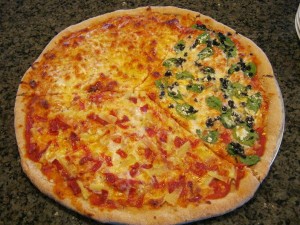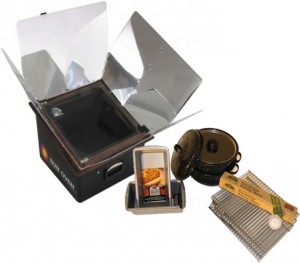Home-made Whole Wheat (freshly milled!) Pizza Crust can be made easily ahead of time to make even the most hectic evening meals both fast and healthy. With variety and choices of toppings it can be a great family pleaser! I mean, who doesn’t like to choose their own toppings on pizza, right?
From fresh herbs to your own simply made tomato sauce (ground tomatoes) there are endless possibilities to toss on top of this crust and have dinner in a flash. The secret is making several of these healthy crusts ahead of time and freezing them!
Here’s the simple way to do it.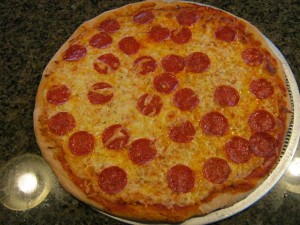
First use freshly milled whole wheat in your favorite recipe. You can see mine on our VIDEO ARCHIVES.
Second, buy the large turkey roasting bags at the grocer.
Third, when making these only par-bake them at 350 for between 8-10 minutes until lightly cooked.
Then cool completely, bag and put in the freezer. Stack them inside the turkey roasting bag, twist tie and freeze! Ready to be used when you’re short on time, but don’t want to short change your family on healthy food!
Then when you have only 15 minutes to have dinner on the table – pull one out, decorate as you like and bake for about 10 minutes at 400 degrees. Within less time than it takes to drive to the take-out pizza place you’ve got a far healthier and budget friendly dinner ready to go!
By using freshly milled whole wheat – you also enjoy the flavor of the pizza without the over powering taste of the bagged whole wheat flour ruining the sauce, cheese and toppings! So if you’ve not thought of a mill you’d like yet…please view our GRAIN MILL COMPARISON CHART to get started!
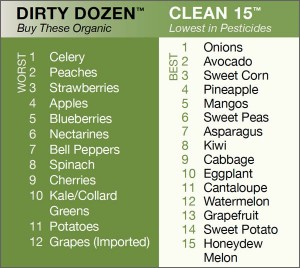 If there were one budget benefit to the rising food prices of our current economic climate, it would be that the prices of ‘regular’ produce have virtually met the price of organic produce. Now making the choice between the two options does not have the same wide cost comparison. Yet again, knowing just what to purchase as organic and what is lower in pesticides is always a good thing to keep in mind when trying to provide healthy foods on a budget.
If there were one budget benefit to the rising food prices of our current economic climate, it would be that the prices of ‘regular’ produce have virtually met the price of organic produce. Now making the choice between the two options does not have the same wide cost comparison. Yet again, knowing just what to purchase as organic and what is lower in pesticides is always a good thing to keep in mind when trying to provide healthy foods on a budget.
There are lists like the one pictured here in this article that can be helpful in deciphering just what to spend your money on when planning your grocery budget. Organic Produce and Low Pesticide Produce are categorized into the ‘Dirty Dozen’ or the ‘Clean Fifteen’. The trick here is to remember them. I can barely remember to take the list of needed items and coupons, so this additional list will likely get left on the kitchen counter instead of in my hand at the grocery store. However, there are a few tips and tricks to help you remember what are the best choices:
- Print out and potentially laminate the list above and keep it in your wallet or check book. This way it is always with you, even when you happen upon a farmers market or fruit stand. I also do this with printer cartridge information for the copier.
- Forgot your list? No worries, just remember that most of the fruits and vegetable s that you also eat the skin or peel (or that the peal is fuzzy and absorbent) you will want to purchase as organic. Produce that you peel or remove the outer layer are often lower in pesticides both during the growing process and you habitually lower the intake by removing the outer layer before consuming.
- Most produce has 4 to 5 numbers on the sticker. Look at the first one to know what you are getting: Starts with a “9” – Organically Grown and non GMO. Starts with “3 or 4” – Conventionally grown, not genetically modified (non-GMO), but also not organic. Starts with an “8” – Genetically modified (DNA altered), so hate eight.
- Last but certainly not least, and definitely the most trustworthy and budget friendly approach….grow your own! Not only will it save money, you’ll have the satisfaction of knowing what went into the process, appreciate the end product and enjoy the taste far more!
Hopefully this will help as you approach your produce selection to feel you are confidently spending your hard earned budget money on food that best nourishes your family. Listen to the April 18, 2012 episode of “Encouragement in the Kitchen” for more insight and encouragement about this topic.
Next week on April 10th, 2012 Millers Grain House is delighted to be offering a Solar Cooking Class at the local fairgrounds. Given the price of electricity and the need to practice greener, self-sustaining skills, the Global Sun Oven is becoming one of our new favorite cooking options.
The Dehydrating Prep Pack makes this a very versatile oven that does far more than slow cook! It’s not your chintzy solar cooker.
The Global Sun Oven bakes, broils, steams, dry boils eggs, purifies water, dehydrates and can be used to sprout! This is the only solar cooking device that we have found to reach baking temperatures of up to 400 degrees. Most people know that to bake muffins or bread, it must reach and sustain this temperature. It does!
At the upcoming class we will demonstrate baking muffins and meat and dehydrating a 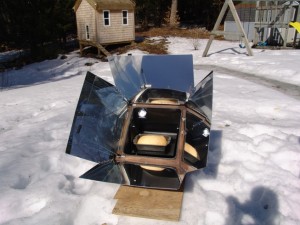 variety of foods. Each participant with get to play with the Global Sun Oven and see just how easy it is to use. This is my favorite new toy, I mean, tool! So much so, that it feels like I’m playing with an easy bake oven!
variety of foods. Each participant with get to play with the Global Sun Oven and see just how easy it is to use. This is my favorite new toy, I mean, tool! So much so, that it feels like I’m playing with an easy bake oven!
The versatility and durability of the Global Sun Oven has made it to be my only recommended Solar Oven to date. There really is no match to it.
Stop by here and see how my very first loaf of freshly milled whole wheat bread in the Global Sun Oven did! It’s the video in the lowest left hand corner. EnJOY!

